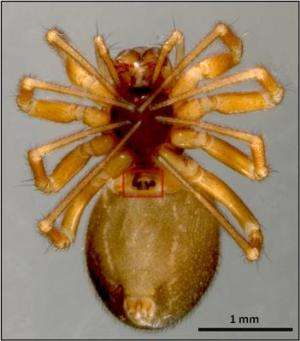Male dwarf spiders ensure offspring is their own

Chastity belts were not first invented in mediaeval times - members of many animal groups have evolved similar mechanical safeguards to ensure their paternity. Male dwarf spiders, for instance, use mating plugs to block off the genital tract of the female they have just mated with. The larger and older the plug, the better the chances are that other males will not make deposits in a female's sperm storage organ, too. So says Katrin Kunz and co-authors of the Zoological Institute and Museum in Greifswald, Germany, in an article published in Springer's journal Behavioral Ecology and Sociobiology about this European spider.
This study builds on previous research led by co-author Gabriele Uhl that showed that dwarf spider males (Oedothorax retusus) insert mating plugs into the two copulatory ducts of the females they have mated with.
Kunz and her colleagues took these findings one step further to study just how well the mating plugs of the dwarf spider work. They discovered that the material the plugs are made of is transferred in a liquid state from the male to the female and that it needs to harden to a certain degree before it can withstand penetration or removal by a rival male. Remating trials were then staged after females received plugs of different sizes during a first round of copulation. Their effectiveness over periods of time was also tested. The female spiders were then scrutinized under a scanning electron microscope.
Overall, small plugs were found to be less effective than large plugs. This suggests that smaller portions of the translucent plug material can be more easily removed or overcome by a subsequent male that wants to mate. Small plugs are also least effective shortly after they are placed, which suggests that both size and the hardening of the material plays an important role in how well the plug works. Once plugs are older than a day they strongly serve to monopolize access to the duct that leads to the female sperm storage organ.
However, even if subsequent males are able to mate, at least part of their sperm mass remains outside of the female genital tract, confirming the efficacy of the mating plug. Consequently, if a male succeeds in plugging both of the female's copulatory openings, his paternity success is expected to be very high.
"The mating plug in the dwarf spider clearly functions as a mechanical obstacle to rival males," says Kunz. "Mating plugs are a powerful mechanical safeguard whose efficacy varies with plug size and age."
More information: Kunz, K. et al (2014). "Does the size and age of mating plugs alter their efficacy in protecting paternity?" Behavioral Ecology and Sociobiology, DOI: 10.1007/s00265-014-1742-7
Journal information: Behavioral Ecology and Sociobiology
Provided by Springer



















